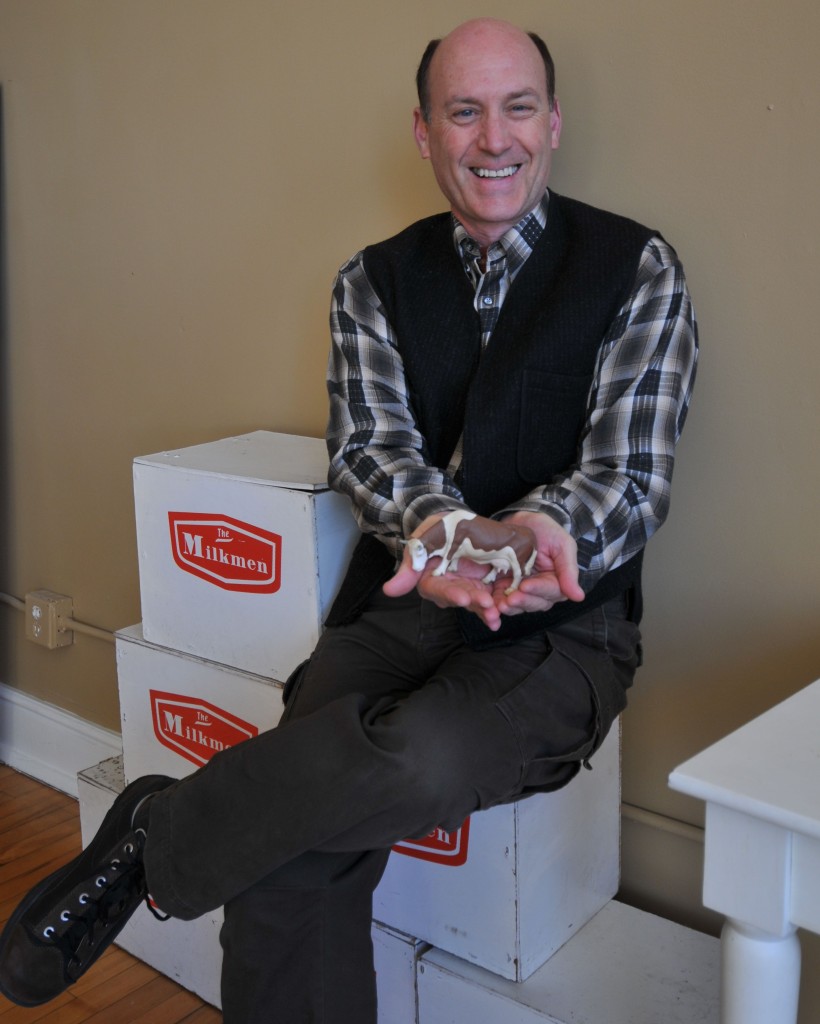Despite mounting evidence to the contrary, certain “esteemed economists” have made careers out of furnishing false information like, “Marijuana is no cash cow” — and mainstream media has compliantly chewed the cud.
The media has been dutifully echoing the limbo-low cannatax and cannajobs projections of economists as long as they’ve been making them. That effectively discourages activists from stocking up on bullhorn batteries to holler for dollars at massive rallies demanding the end of prohibition. Enthusiasm for collecting cannatax and creating cannajobs in lieu of enacting further austerity measures is nipped in the bud.
That’s been the general idea.
In theory, economists are neutral parties beholden to no one in particular. In reality, economists are no different from lawyers and lobbyists; they’re paid to find or not find data furthering the cause of whoever signs their paychecks.
Similarly, mainstream media is owned by individuals just as likely to have personal agendas as not. And some of those individuals with personal agendas actively participate in a global pot conspiracy bound and determined to keep cannabis the commdity permanently banished.
It consists of:
- The federal government
- Wall Street
- The World Bank
- The military-industrial complex
- “Esteemed economists” employed by all of the above
- Mainstream media controlled by all of the above
Brainwashing the citizenry that “marijuana is no cash cow” preserves the status quo: the World’s Most Helpful Substance remains sequestered in perpetual exile. This underdog commodity has been trivialized, marginalized, and ostracized by “esteemed economists” and mainstream media alike. When cannabis is mentioned at all by the same tamden that should be singing its praises to the heavens, it’s rarely characterized as anything more than a lowly weed, one unworthy of playing any appreciable role in aboveground markets.
But there are hopeful signs that mainstream media has finally woken up and realized that there’s something fishy about the starring role economists have played in the long-running production, “Prolonging Pot Prohibition.”
Case in point politico.com’s recent poteconomics piece, “Cash-starved states eye pot tax,” by Rachel Bade.
Bade’s piece follows mainstream media’s time-honored formula for keeping cannabis commerce down:
- Only proclamations from Dr. Jeffrey Miron or the RAND Corporation are safe, sanitized, and blasé enough for general dissemination.
- Reporters must cull poteconomics quotes from lowballers Miron and/or RAND’s Rosalie Liccardo Pacula in lieu of making any real effort to assess cannabis commerce’s economic firepower for themselves.
- Figures tossed-out by Miron/RAND must never be questioned.
- The
tricksmethodology employed by economic conjurers like Miron/RAND must never be disclosed. - Act as if abysmally low cannatax projections made by Miron/RAND up to a decade ago are newsworthy.
Unexpectedly, “Cash-starved states eye pot tax,” deviates from the norm by quoting freshly-sanctioned voices, including:
- Colorado Congressman Jared Polis
- The Colorado Center on Law and Policy
- California NORML’s Dale Gieringer
- The State of Washington’s Office of Financial Management
The result: Politico’s piece is noticeably more objective than typical mainstream fare.
The five-leaved superfiber’s prodigious upside is actually explored; previously, publishing opinions by poteconomists not named Miron or Pacula has been considered heresy.
Objective or not, I found myself tiptoeing through through a minefield of misinformation unchallenged by Ms. Bade or Politico’s editors. I took that as a cue to get off the disabled list and get back in the game; someone has to stick up for the magical weed … someone who isn’t intimidated by “esteemed economists” and their fancy degrees.
Consider Deconstructing Poteconomics Coverage your guide to reading between the lines of mainstream media’s often-bungling attempts to address “the revenue issue” — that is, whether or not collecting cannatax or creating cannajobs are compelling reasons to repeal federal marijuana prohibition. The same principles apply whether you encounter poteconomics coverage in print, online, or via the airwaves.
First we’ll duke it out with the best known and most pessimistic economists, then we’ll moo-ve on to greener pastures.
Note: I prefer offering my own takes on cannatax and cannajobs to disparaging other projections; toward that end, I’m already deep into Canntax 2013 and Cannajobs 2013. However, some widely-circulated projections are so destructive — preventing 1 million cannajobs from being created and an easy $75 billion in cannatax from being collected — and these stories are so widely disseminated, that I’m not going to beat around the bush politely debating big-name economists bullshitting the public that marijuana is no cash cow.
If you like your poteconomics served tame, tepid, and tasteless, then this isn’t the dish for you.
Leading off: Every chance she gets, Her Wickedness sics flying blue monkeys against Ganja Nation.
Rosalie Liccardo Pacula: La strega malvagia dell’ovest

“You, your Auntie Em and your little dog won’t be growing any ganja or hemp in Kansas, my pretty! Seize them! Eradicate their fields!”
La strega malvagia dell’ovest [translation: The Wicked Witch of the West], the RAND Corporation’s Rosalie Liccardo Pacula, is the poster girl for poteconomists who come haughty, cryptic, and unfailingly unenthusiastic.
That’s haughty as in being far too grand to email a polite “no, thanks” to any of three interview requests. Misleading mainstream reporters with looming deadlines too busy to force-feed themselves poteconomics is far less daunting than facing someone certain to press you for:
- Plausible explanations why your cannatax forecasts are based solely on DEA data
- An explanation for the fact that after analyzing the industry for a decade, you’ve never found one remotely positive thing to say about cannabis commerce— despite the presence of wildly successful businesses that have taken root in your own backyard
- Who funds the RAND Corporation’s Drug Policy Research Center
Cryptic, as in obfuscating cannatax figures by presenting them as esoteric calculus symbols intended to impress readers how she can routinely perform arcane calculations that would stump Star Trek’s Dr. Spock.
Take this sample from Marijuana Markets: Inferences from Reports by the Household Population:
It goes without saying that most of you fluent in dabs are also fluent in the ancient Cyrillic symbols RAND’s chief sorceress employs to punctuate her points. I picked up a little of the native tongue at a retreat when I ruminated upon poteconomics at a monastery along the Dalmatian coast; if I were to guess, I believe La Strega Malvagia’s figures indicate that the cumulative effect of vectors of variables adding up is getting you really baked.
And unfailably unenthusiastic as in her stated opinion that there’s somewhere around $6 billion in cannatax to collect for the continental US, Alaska, and Hawaii over the time it takes the earth to revolve around the sun.
I and everyone else who’s either …
- Intimately observed the outlaw market for the better part of 40 years
- Been lucky enough to have had a front row seat for Colorado’s retail explosion during the past three years
- Both of the above
… find the $6 billion figure, which by some strange coincidence just happens to be a mirror image of Jeff Miron’s ubiquitous figure, way “more economical” than a trip to a comedy cub when the mood for rip-roaring belly laughs strikes.

Dr. Rosalie Liccardo Pacula is in denial that cannabis commerce made a spectacular debut on Venice Beach, putting people to work who would otherwise be unemployed and contributing much-needed cannatax to help maintain the city’s famous beach and boardwalk.
Uh, Your Wickedness, what about all those “The Doctor Is In” signs prominently placed on the Venice Boardwalk — a block from where you work?
MMJ has no more economic potential than Toe Rings.
How about all the cannabis cultivation in northern California’s Golden Triangle that’s dazzled the world?
Big deal.
And the fact that the Department of Agriculture’s stats lists pot as your home state’s #1 cash crop?
So what?
Perhaps you’re getting an inkling that the second most-quoted poteconomics authority on earth is:
- Someone with no personal interest in cannabis whatsoever; that’s akin to someone with no personal interest in dogs entering Lhasa Apsos in the Non-Sporting Group of the Westminster Kennel Club Dog Show
- Someone who finds it impossible to get out of her own head and find anything to praise about an endlessly fascinating plant
- Someone who acts as if her primary role is hosing off cannabis’ economic firepower whenever the media dials RAND
Let’s take a look at some of the sparkling insights RAND’s marijuana maven provided for “Cash-starved states eye pot tax.” Quotes from Politico’s article appear in red.
“When you go to legalize, you have reduced risk in producing and distributing the drug. That’s a real component of the monetary price of marijuana,” said Rosalie Liccardo Pacula, the co-director of the RAND Drug Policy Research Center.
In this first quote, Dr. Pacula — a woman with zero interest in legalization or unshackling cannabis commerce so that others could have good jobs, too — breaks the news that legal items cost less than illegal items. That’s really going out on a limb.
Not only is there nothing new or different in that utter-ance, statements like that plant the idea in peoples’ minds that because competition in the thus far quasi-legal retail marketplace inevitably forces the price of cannabis down, why even bother legalizing it? We’re just talking about diminishing returns, right? Why not curl up with a bag of Doritos on the couch and fixate instead on March Madness, The Bachelorette, and whether that shiny new 2013 Escalade is really more powerful and more luxurious than the 2012 model?
I can think of 70 billion reasons why.
Is it not worth generating $70 billion worth of cannatax today even though six months ago the same amount of marijuana would have generated $76 billion worth? We could sweat the “lost” $6 billion. Alternatively, we could be thankful there’s $70 billion just sitting there for the taking, like Easter eggs sparkling on a manicured lawn.
I don’t know everything, but where I’m from $70 billion ain’t exactly hay.
Don’t even get me started on La Strega’s Malvagia‘s choice of the word “drug” in her aforementioned statement. If that’s not a dead giveaway which side this esteemed economist’s bread is buttered on, I don’t know what is.

Rosalie Liccardo Pacula would have us believe she had no idea that MMJ took over the boardwalk at Venice Beach, mere blocks away from the RAND Corporation’s architectonic headquarters.
“She expects prices to fall by 70 to 85 percent in both Colorado and Washington — and that means taxes, if levied as a percentage of price or value, will also fall considerably.”
Earth to Politico: from what point, in what state, in what time frame, are we talking about?
Are we talking about an actual drop from an average price of $450 an ounce at retail in Colorado in 2010 to the $150 an ounce range in 2013? Or a theoretical fall from the $150 an ounce range at retail in Colorado in 2013 to the $40 an ounce range in 2016?
You’d almost think Politico assumes that no one reads their articles carefully enough to catch ambiguous statements like that.
Think again.
“But she acknowledges that it’s hard to know for sure.” ‘You have to know more about the structure of the demand curve, which we don’t have any data on because this is black-market; it’s all conjecture,’ Liccardo Pacula said.”
- “It’s hard to know for sure?” A pet detective could tell us that. The statement is newsworthy, because … ?
- Is it really that hard to know for sure what’s going on in your backyard in Santa Monica? The Venice boardwalk may as well be Trenchtown West. Pull-ease.
- In what year did Her Wickedness make the statement, “This [marijuana sales] is black market; it’s all conjecture?” Countless documented dispensary sales have taken place from 2009–2013 in Colorado and California. The depth and breadth of these sales take “conjecture” out of the equation. While you may be forming the impression that I don’t hold RAND’s High Priestess in high regard, even she knows there’s a vibrant quasi-legal market in addition to a booming black market — she’s just paid to clam up about it. I’m guessing this is probably a quote from 2010 or earlier appearing in a 2013 news story. If it actually is a recent statement provided expressly for the purposes of this article, RAND lets its Co-Director of the RAND Drug Policy Center out of her ivory tower even less often than I thought — or Politico’s editors are smoking something I’d love to review.
At this point you may be wondering if there’s anything nice I can think of to say about Dr. Rosalie Liccardo Pacula. There is.
“Altered State,” her title for a dismissive white paper about California’s prospects for generating cannatax from the since-defeated Proposition 19, is creative enough.
I also enjoyed La Strega’s Malvagia’s similarly creative choice of the word “cratering” to express prices falling in potspots like Denver where heavy retail competition exists. Then again, “cratering” is an entirely negative term symptomatic of an entirely negative view of the canniverse — one which just happens to mesh perfectly with the anti-pot programming various branches of the US government grease RAND’s palms to effect.
What’s really galling is that La Strega won’t apply one iota of her God-given creativity to finding pot-ential sources of cannatax that someone who doesn’t even have a BA but who does have a lot of want-to had no trouble identifying. If she was a neutral observer [fat chance], she’d rejoice that there’s an unlimited source of uplifting news in bleak economic times … and the the whole world would stand up and take notice.
Nope. Not happening.
Unfortunately, the continued silence of certain economists paid to clam up about pot-ential cannatax and cannajobs isn’t neutral. It’s fatal for free-flowing cannabis commerce, condemning it to a constricted trickle instead of the raging river it was intended to be. Why? Because until they hear it from an “authority,” people don’t believe that there’s enough cannatax and/or cannajobs to make legalization worthwhile.
Unspoken-but-implied messages from anti-pot forces channeled through RAND’s drug spokeswoman:
- “You’re all in a dream world that cannabis could, would and should be traded like petroleum, pork bellies and copper.”
- “Don’t even think about repealing prohibition, it’s too entrenched. You’re powerless and you’ll just be overwhelmed if you choose to fight. Embrace those puny one-ounce limits or we’ll bury you.”
- “You’re all a bunch of stoners and there’s no place for stoners in The New World Order.”
I’ve come down hard on Rosalie Liccardo Pacula — but not nearly as hard as she’s come down on cannabis commerce at every possible turn. Me coming down on her might affect her. Her coming down on cannabis commerce definitely affects all of humanity. It keeps people on five continents down, unemployed or underemployed. More and more governments will go bankrupt, unable to aid citizens who need help the most.
My message to La strega malvagia dell’ovest and her totally-beholden-to-the-military-industrial-complex-and-worse stink tank: “Melt, baby, melt — just like you’ve done your best to melt the hopes and dreams of everyone who appreciates the magical weed and longs to earn a living in the marijuana field.”
Missing in action: a woman economist who’ll step up and and represent The Good Witch of The East. If you’re out there, click your heels three times and appear!
“Marijuana is no cash cow,” Miron Moos For Media
Jeff Miron and I have rumbled more times than Pacquiao/Marquez. I’ve lost count; this latest go-round could be Kohn/Miron XVII.
Curious readers can type “Miron” into Cannabis Commerce’s Search box and sample three years worth of critiques simultaneously praising and skewering the most-quoted man in marijuana.
Unlike the preeminent female economist from Santa Monica, Miron dismounts his high horse from time to time and lets you know why he says the things he does. That’s good information — though it doesn’t make his unvarying put-downs of the marijuana trade any more palatable.
Miron’s candor makes it simple to paraphrase his position in one sentence: “Even though I’m a top-gun economist, I can’t or won’t muster as much as one syllable’s worth of enthusiasm for collecting cannatax or creating cannajobs … but pot should be legal because it’s a personal freedom guaranteed by the Constitution.”
Shorter still, “I’m a libertarian.”
A libertarian streak runs rampant throughout the ranks of elite economists, an association Cannabis Commerce tenderly probed in What is a Poteconomist and Why are the World’s Esteemed Economists Mum on Pot?
One variation on the theme is a real mind-bender.
Libertarian economists championing pot legalization as a personal freedom issue — ignoring the revenue issue in an age of austerity — is an extraterrestrial stance. Why not call themselves “Capitalists Against Capitalism?”
Dr. Miron is without competition the poster boy for libertarian economists; his pronouncements provide them and us with life-giving fodder.
Speaking of cow chow, let’s serve up a sampling of the enigmatic one’s latest and greatest mooing for Politico:
“This is not a cash cow that can solve anyone’s fiscal problems,” said Harvard economics professor Jeffrey Miron, a pro-legalization scholar at the libertarian Cato Institute.
This not a scholar who can solve anyone’s fiscal problems. Truck Driver Institute instructors can tell you more about “weed, whites, and wine” than Miron, Senior Lecturer and Director of Undergraduate Studies in the Department of Economics at Harvard University in Cambridge, Massachusetts.
Denial is only one small step from dishonesty.
If a golden Guernsey stood one hundred yards high, its four stomach cavities stuffed with Kosher Kush and hundred dollar bills, and it roller-skated into Harvard Square singing arias from The Marriage of Figaro, the libertarian darling would never admit anything was up.

420 Denver 2013: More proof that “marijuana is no cash cow.” Yeah, right — if the 80,000 attendees at this rally consumed a quarter ounce of cannabis each over the course of World Cannabis Week, that would be 80,000 x $50 or $4 million spent by this crowd alone.
That doesn’t exactly help sell full legalization to politicians or the public.
Dr. Miron doesn’t care. He just keeps repeating himself ad nausem; why shouldn’t he — mainstream media hasn’t called him on it yet. That’s not true for “minorstream” media: you’re reading it right now.
At least Our Man Miron is “pro-legalization” as in pro full legalization [yes, the repealing federal prohibition variety].
Amen to that.
Miron’s libertarian leanings lead him down the path of repealing prohibition — as opposed to spending the next millennium trying to effect quasi-legalization state-by-state, the moronic modus operandi exclusively employed by our most recognizable activist groups. Ironically, some common ground between Harvard’s finest and the heathen warrior storming his gates exists.
“There is a lot of exaggeration about how big the revenue can be.”
It’s déjà vu all over again. In Miron’s stone-free mindset:
- Looking anywhere but DEA statistics for cannatax revenue is “exaggeration.”
- Counting state and federal income taxes is “exaggeration.”
- Counting state licensing fees is “exaggeration.”
- Making an actual effort to uncover new pot-ential revenue streams instead of regurgitating the same report year after year is “exaggeration.”
- Counting potential hemp sales is “exaggeration.”
- Checking in with outlaw growers is “exaggeration.”
- Putting himself out any more than the bare minimum is “exaggeration.”
- Any statement made by others which doesn’t sound like a broken record demeaning the juggernaut that cannabis commerce is ready, willing, and able to become is “exaggeration.”

The hallowed halls of Harvard: If someone has a Ph.D. from an Ivy League university with all this tradition, their poteconomics predictions are unchallenegable. Or are they?
Advocates “want to be allowed to smoke in peace,” Miron said.
Uh, hello, they also want to be allowed to make money in peace. And there’s an awful lot of it to be made and taxed at sensible rates [not the sky-high 60% Miron unfathomably believes people will pay because that’s the going rate for gasoline taxes in some principality somewhere].
But, they’re “nervous about making that argument. They’re afraid that argument won’t win the day, so they have focused in many cases on the revenue side.”
- Translation: “I’m a libertarian and you’re not. You actually think you have a right to make money in marijuana like I make money in academia. Who do you think you are?”
- I was unaware that your personal freedom argument has won the day. Exactly when and where did this triumph take place?
- Please exclude me from the Nervous Nellie list: I haven’t stopped arguing with you for three years. I’ll rumble with you any time, any place. You’re paid to cover-up pot-ential cannatax revenue and you’ve never given your backers any reason to ask for a refund.
- It’s true that I’m afraid “the argument won’t win the day,” that is, as long the media keeps turning to an unmotivated non-stoner for pot quotes and keeps getting unmotivated non-stoner replies.
Imagine that ESPN hired someone who who detests everything about football as a color commentator for its Monday Night Football broadcast.
“And now, for an opinion on whether the 49ers untested rookie cornerbacks will be able to hold off the laser-like throws of All-Pro Packers quarterback Aaron Rodgers, let’s go now to Milton Miron:”
“Hey, Irv. You know how much I hate football, and how I could care less about rookie cornerbacks, and how I wouldn’t recognize Aaron Rodgers if I bumped into him at Sausages”R”Us, and how I can’t stand all those military jets flying overhead during the Star-Spangled Banner, and how bored I am by all those cheerleader hotties prancing around in hot pants and mock cowboy boots; but I’m extremely cautious … I wouldn’t bet on Rodgers throwing for more than 27 yards.”
“In the first quarter, Milt?”
“No, Irv, in the entire game.”
Wackily enough, conventional media keeps the never-colorful Jeff Miron on speed dial lest it miss out on any of his famously desultory poteconomics quotes.
Here’s the gold standard, dutifully parroted for the 2,734th time, this time by Politico:
Miron estimates that a nationwide legalization that taxed marijuana like alcohol and tobacco would mean $6.4 billion in new tax revenue — $4.3 billion for Uncle Sam and $2.1 billion for the states.
Politico offers us yet another glimpse of Miron’s fallacious-yet-tremendously-enduring $6.4 billion total cannatax figure. It’s a sure thing, like hearing “More Than a Feeling” six times a day on Classic Rock stations.
Aside from the fact $6.4 billion was never real — as those of us who’ve spent huge chunks of our lives familiarizing ourselves with outlaw poteconomics know beyond a shadow of a doubt — something else is rotten about encountering it in April, 2013.
As it develops, Miron told a folksy little hometown newspaper you may or may not have ever heard of, a little rag called The New York Times, that he thought that US stoners spent $25 billion on marijuana in 2010 — meaning the cannatax formula he used to identify $6.4 billion cannatax from $10.5 billion in total sales translates to something like $15 billion cannatax on $25 billion sales.
The Times’ exact quote: “Americans spend roughly $25 billion a year on marijuana, according to the Harvard economist Jeffrey Miron, which gives some idea of the popularity of this drug.”
When challenged by Cannabis Commerce, Miron, who swore up and down that he would never, ever budge from his $6.4 cannatax billion prediction based on total sales of around $10.5 billion — since “there is no way demand for marijuana will ever increase” — he wavered momentarily before holding firm at, “$17 billion, final offer.”
Even I, who balked at Calculus, much less Advanced Calculus — and never caught a whiff of an economics class while never turning down a whiff of Lebanese Blonde Hash, Temple Balls, or Thai sticks — can calculate that $17 billion in sales lifts the Cambridge soothsayer’s revised cannatax prediction into the neighborhood of $12 billion per annum.
Yes, I’m pointing out that neither the author, the editor, nor the fact-checker of “Cash-starved states eye pot tax” noted that Miron had doubled his cannatax forecast.
Unfortunately, the primitive and DEA-friendly figure Politico went with was immediately picked up by every wire service — searing the outdated and detrimental cannatax figure onto the collective unconscious.
Maybe by 2025 or so mainstream media will stop treating Miron’s $6.4 billion forecast from the pre-MMJ era which isn’t even a tenth of what’s out there as a proclamation from on high … but I wouldn’t count on it.
This concludes the surrealistic portion of our program.
Next up: a Congressman who gets it.
Colorado Congressman Jared Polis weighs in

Colorado Congressman Jared Polis has come out of the closet in support of controversial issues without worrying about potential political backlashes. What’s more, it’s working for him!
“I’ve seen some estimates in the high tens of millions, as much as $100 million [worth of cannatax on medical and recreational pot that could be annually collected] for Colorado,” said Rep. Jared Polis [D-Colo.], who’s pushing federal legalization in Congress.
God bless utterly transparent Colorado Congressman Jared Polis. He came out as a gay politician and was still elected in a landslide. He completely gets cannatax. He completely gets the importance of “pushing federal legislation [not just state-by-state variants] in Congress.”
But where does “as much as $100 million come from?” Politico offers no clues.
To uncover that, we’ll use the Colorado Department of Revenue’s [DOR] own figures.
Unlike other states, Colorado fastidiously documents MMJ stats — stats we can use to demystify Congressman Polis’ alluring figure. Actual MMJ stats allow us to extrapolate RMJ [recreational marijuana] stats.
Fear not — if you can balance a checkbook, you can follow this middle school math:
- According to the DOR, in fiscal year 2012 Colorado collected about $6 million in sales tax on marijuana and marijuana infused products sales.
- The average sales tax for the state of Colorado is 7.25% according to the DOR [interestingly, the national average is 9.9% according to taxfoundation.org, meaning that other states could collect 25% or more cannatax than Colorado].
- 7.25% [the sales tax] is about 13.8% of 100% [the purchase price].
- Multiply $6 million [Colorado’s sales tax collected by DOR] by 13.8% and arrive at $82.8 million [the dollar amount of Colorado’s total 2012 MMJ sales].
- That means that about $83 million worth of marijuana and marijuana infused products had to have been sold in Colorado in fiscal year 2012.
That’s the bottom line. Pure and simple. It is not and cannot be a personal opinion.
But wait — there’s more.
- Growers as a rule of thumb generally factor cultivation costs at around 20% of the purchase price of marijuana and marijuana infused products. We’re talking about seeds, soil, nutrients, lights, containers, clones, etc.
- So growers are spending 20% of $83 million on cultivation supplies which are often taxable.
- Even if some cultivation supply sales were purchased through the internet and weren’t taxble, there are so many other ways cannabis commerce radiates out into the community like drywall sales which are taxable for build-outs, head shop sales, and other required purchases like pricey HVAC supplies that I’ll stick with the 20% guesstimate.
- $83 million [total sales] multiplied by 120% [cultivation sales at 20% of purchase price is factored in] = $99.36; call it $100 million.
So we’ve already reached $100 million in total sales for MMJ alone. So then, how much bigger will RMJ sales be than MMJ sales?
I’ll lick my way across Kansas if RMJ [recreational marijuana] sales aren’t four times greater than MMJ sales assuming that the federal government allows these sales to take place in peace.
That’s a preliminary estimate based on the actual number of Colorado medical users taken as a percentage of the estimated number of monthly users according to DEA stats, also around 20%.
After all, entering the marketplace will be:
- Anyone averse to their name appearing in a stigmatic government database like teachers, firemen, servicemen, etc.
- Anyone averse to their face appearing on Cannabis Camera
- Cannabis tourists, who absolutely swarmed all over Colorado 420 celebrations last week.
- Anyone seeking a get-out-of-jail-free card to drive freely around the state with a bag of weed
- Seniors no longer hiding behind a medical reason to purchase weed
- Anyone averse to paying a doctor for a recommendation and the state for red card
- Anyone averse to feigning an illness to meet strict state criteria for a physician’s recommendation
- Anyone who didn’t enjoy playing “make believe” as in assuming the role of “patient” just because they wanted to get their hands on some weed
- Anyone who wants a better deal and a broader selection than the the outlaw market offers (buying from a friend of a friend of a friend).
So now we’re looking at the very real possibility of $400 million in total sales [4 x $100 million = $400 million].
7.25% sales tax on $400 million comes out to $29 million in cannatax. [$400 million x .0725% = $29 million].
But we’re just warming up.
We haven’t accounted for excise or sin taxes, which were penciled into Amendment 64 [legalizing recreational pot] at 15% of sale price. While I’m not a fan of Amendment 64 with it’s lamentable one-ounce limit and opt-out provisions, I concede that 15% sin tax is the sweet spot for collecting substantial cannatax without scaring anyone off.
Let’s stir those into the pot, too: 15% of $400 million = $60 million in sin tax.
$29 million [sales tax] + $60 million [sin tax] = $89 million in cannatax.
Still, that’s not quite $100 million. No problem.
It remains to be seen whether the State of Colorado will require licensing fees for RMJ like it does for MMJ.
Licensing fees are a ripe source of cannatax. In fiscal year 2012, these amounted to $3,336,000 — and that’s while a moratorium on new applications was in effect. The number for fiscal year 2011 was $8,444,750. These figures are available to the public [page 25]; they’re not a vision that came to me in a swirling vapor.
And what about state income taxes? Support workers and key personnel will most assuredly be paying these — unless anyone wants a refresher course in “Al Capone” laws (you have to pay income taxes whether you sell legal or illegal goods). There’s millions upon millions there as well, likely to push the cannatax total Congressman Polis cited over the $100 million mark.
“Money like that could make a big difference, he [Polis] said — including a “substantial dent in needed school improvements, particularly in poorer districts.”
That’s certainly true; it’s also true that school improvements are just one example Congressman Polis could have cited — all forms of governmental infrastructure from community dog runs to highway overpasses benefit from cannatax infusions.
Reporter Bade might have noted the full-spectrum of benefits but left us hanging at school improvements. And, oh by the way, speaking of “cash-starved states” … are there any that aren’t? Just wondering.
The Colorado Center on Law and Policy
“The Colorado Center on Law and Policy last August [2012] estimated that legalization would bring in $24 million in excise tax revenue, $8.7 million in state sales tax revenue and $14.5 million in local tax revenue.”
The key variable absent from a statement like this is: “how did this hokey organization — staffed by wholesome, churchgoing folks whose combined stash couldn’t fill a thimble — calculate how much bigger the recreational market is than the medical marijuana market?”
Apparently that’s a mystery, like who built the Martian canals.
You may have noticed that The Center’s total cannatax figures of $47 million [$24 million + $8.7 million + $14.5 million = $47.2 million] are less than half of Congressman Polis’ $100 million projection. I could suggest that’s because it fails to account for the aforementioned sales taxes on the cultivation supplies [productions costs are consistently overlooked by non-stoners], licensing fees, and state income taxes paid by industry workers; but if you really want to get down to it, it’s the difference between figures calculated by persons detached from the outcome vs. figures calculated by persons truly excited by the outcome.
Clarification: you don’t fudge cannatax figures just because you’re excited by the benefits of full legality, you just look more places for pot-ential revenue streams more purposefully. This requires an aptitude for visualizing a future replete with legal pot. You sense that it’s absurd weed sales are currently prohibited at music concerts, and you have a feel for how much of it would be sold if Phish played three sold-out shows at Red Rocks Amphitheatre. Heck, the band could sell its official Phish Phertilizer strain specifically formulated for that series of shows — and the band’s freakishly loyal fans would scarf it up every last gram.
That’s why, in this particular niche, my money’s on poteconomists to out-calculate conventional economists every single time.
The Washington State Office of Financial Management
“Washington’s Office of Financial Management estimates that marijuana revenues levied on growers, processors and retailers will bring in just over $565 million in 2017.”
Uh, “revenues” are not levied on growers processors and retailers; those would be “taxes.” $565 million represents Washington’s projected total sales, not cannatax revenue. The sales tax on $565 million in total sales factored at Washington’s average rate 8.83% according to taxfoundation.org works out to give or take $50 million.
$565 million x .0883 = $50 million in State of Washington sales tax alone.
But wait — didn’t “esteemed economists” Miron and Pacula assure us there was only a fraction of that amount possible in Washington? What are they smoking up in the northwest? The truth. We just calculated a similar figure for Colorado’s total sales [$460 million not counting fees and income tax]; Colorado’s 25% smaller population accounts for the difference.
In other words get used to the ka-ching of cash registers ringing all over the Evergreen State.
Also note that Washington’s quoted $565 million estimate is for fiscal year 2017, allowing for sufficient ramp-up time.
And what if hemp takes off? That question’s out of the scope of this post, but taxing hemp and other revenue streams holds considerable upside for Washington, Colorado, and every other state. We’re not going there because thus far hemp has been all pie in the sky and the vast majority of hemp activists — always eager to talk up a plant with no history of creating wealth in the 21st century — have yet to plant hemp seed one.
But there’s another upside we’d be remiss if we didn’t mention.
According to the latest US Census figures, the population of Washington [6,897,012]is almost exactly 1/45 of the population of the US [313,914,040]. Therefore, if the Washington’s Office of Financial Management’s estimate is correct, pot-ential cannabis sales across the entire nation can be calculated by multiplying $565 million by 45 and arriving at $254,250,000,000. Folks, that’s $245 billion worth of weed sold annually from sea to shining sea.
Honestly, I feel $245 billion is a little overzealous straight out of the gate — but possible by 2017 with a little nurturing from the same government with an 80-year history of spraying our hopes and dreams with Agent Orange.
I’d love to hear how the State of Washington arrived at its figures. Sure, I could call over to the Office of Financial Management and hear all about it … but I’m inclined to accept its figures as presented since Washington is comparable to Colorado in size, population, and attitude.
Dale Gieringer, Director of California NORML
“Dale Gieringer, Director of California National Organization for the Reform of Marijuana Laws, estimates that legalizing pot would bring in at least $1.2 billion to his state alone.”
What you’re not going to get from mainstream media is any cannanalysis of the telling last three words, “his state alone.”
What’s so meaningful about those three little words? They serve as a signpost that the best-known “activist” groups — NORML, ASA, MPP — have long given up the rallying cry of “Legalize it!” [it meaning all marijuana for all people all the time everywhere, not some marijuana for some people in some states] as surely as they’ve given up working together to repeal federal prohibition.
Now it’s every state for itself.
When it’s every state for itself, the splintered effort means way less cannatax is going to be collected. The constant threat of federal reprisals — not to mention in-state opt-outs and each state’s predilection for deleting rights that were voted for after the fact — insures that every marijuana-based business in every state remains in a perpetual state of red alert.
The fine state of California ain’t gonna collect jack if US Attorney General Eric Holder reaffirms the supremacy of federal laws over statewide marijuana initiatives and calls upon his brainchild, an “internal army,” to show how dead serious he is that dissidence = terrorism.
Efforts to collect cannatax in The Golden State will dance in quicksand as long as the four California US Attorneys continue to seek career-making cases from “perils” like pot cotton candy … and calling in the DEA for smash-and-grab raids on state-law abiding cannabis businesses which manufacture them. Cali leads the nation in this sorry enterprise.
To the best of my knowledge, mainstream media’s poteconomics coverage hasn’t said boo about how passing statewide initiatives cements federal marijuana prohibition in place. Dispensing with federal marijuana prohibition essentially opens the floodgates for cannabis commerce.
So why aren’t activist groups all over it?
As it develops, cementing federal marijuana prohibition in place guarantees further funding for the likes of NORML and its revised mission to take the long way round and quasi-legalize in 50 states separately, doesn’t it?
NORML continues to publicize statewide cannatax figures leading anyone curious about cannatax to naturally conclude that if the best-known activist group in America can’t be bothered with national figures, why should they care?
If the previously mentioned activist groups all banded together and worked diligently at repealing prohibition instead of promoting puny one-ounce limits in individual states, it would work … and all paid activist group employees would then be out of jobs.
That prospect clashes with the animal instinct for self-preservation.
I’ve mentioned all this because, to a layman, the sound of Mr. Gieringer’s $1.2 billion projected cannatax figure for California may have a pleasant twang to it. I don’t know everything, but I intuit that sums like that will never be collected without repealing federal prohibition. Essentially, $1.2 billion is a hollow figure.
“His study assumes a traditional sales tax plus an additional $50 levy per ounce of marijuana, which runs between $280 and $420.”
Um, how about a link to “his study?” Or does Politico and every other mainstream publication consider typical readers too dimwitted to tackle such a study? Uh, I’m afraid we can guess the answer.
And how about a reality check on “between $280 and $420 an ounce?” There haven’t been $420 ounces in Denver since 2011. $250 is top shelf stuff in 2013. Someone take the bong away from Politico’s fact-checker. Or hand them one as the case may be.
Tack on the $50 sin tax — I meant the “additional $50 levy per ounce of marijuana,” sorry, and we’re talking about imaginary $470 ounces which may exist in states without dispensaries or ones where they just opened for business — but are gone like yesterday in states that already have them.
Has Politico ressurected another quote from the days of yore? Could be.
“His study argues that legalization could also generate $12 billion to $18 billion in new economic activity for California.”
In an ideal world with prohibition vaporized, $12 billion to $18 billion worth of “new economic activity” is supportable considering California’s population and its dire economic need. One might argue that it’s already supported in Humboldt and Mendocino counties alone.
Extra Credit: Deconstructing mainstream cannajobs coverage
So far you’ve learned how to read between the lines of mainstream poteconomics coverage and decipher what’s said and what’s not said about cannatax.
But what about cannajobs?
Let’s quickly touch upon what’s not said in a typical jobs report.
A perfect example for our purposes is the Los Angeles Times‘ recent, “Jobs report paints a dreary picture.”
As we’ll see, the same pot conspiracy with cannatax already under its thumb employs the exact same formula to defuse interest in cannatax: ignoring its very existence.
There are two main rules to follow:
Rule #1: 99% of the time don’t even acknowledge the existence of cannajobs or the pot-ential for exponentially more of them.
Rule #2: On the rare occasions you absolutely have acknowledge their existence, speak of them as if there are so few of them there’s no reason at all that anyone in their right mind would care about them.
Needless to say, none of the words “pot,” “marijuana,” or “cannabis” appear in The Times’ piece [following Rule #1] … leading the unwary reader to assume the economic pot-ential of cannabis commerce is so Lilliputian no economist worth his salt would admit it’s a growth industry with anywhere near the upside of, say, bovine biogas generators.
Here’s a few snippets from “Jobs report paints a dreary picture” with cannanalysis added: Quotes from the LA Times are in blue.
“Opportunities are so weak, hiring is so low and demand for workers is so depressed that we’re just having people drop out or otherwise not enter the labor force,” said Heidi Shierholz, an economist at the Economic Policy Institute in Washington.”
Pass the Kleenex, please. Everything sucks, yadda yadda yadda.
Here we encounter a quote from an earnest young woman attached to an “institute.” An “institute” is not just a company or a business; hell no. The term “institute” has been carefully selected to convey the impression that a certain group has privileged access to advanced intelligence in a particular milieu. One particular milieu the Economic Policy Institute is clearly lacking any intelligence about at all is cannabis commerce … where mischievous troublemakers unassociated with “institutes” like myself lurk.
That begs the question, “how did a comparatively uneducated stoner somehow stumble upon the discovery that there are a nice round 1 million jobs begging to be created in the marijuana field while the overeducated economists who should have been there first wiled away their days playing Nerf basketball in their cubicles?”
In fact, it’s been impossible to ignore the existence of cannaworkers because 4,000 of them wearing Support Worker and Key Personnel badges are ambulating about the city of Denver, according to MMED [Colorado’s Medical Marijuana Enforcement Division] stats. Presumably, the LA Times is clueless that these workers exist — even though every other Coloradoan has a handheld device capable of taking photos and shooting videos.
“Demand for workers is so depressed … ”
Really. Is that so? Just about everyone I know demands weed yesterday, today and tomorrow … and while God may have created weed, “he” doesn’t plant it, nurture it or sell it. Those tasks fall to other proletariats, many of whom reside on the unemployment rolls and really wish they didn’t.
“President Obama’s chief economic advisor, Alan Krueger, suggested the automatic federal spending cuts under the so-called sequestration had already begun to hurt the job market, though there was little evidence of that in the March report. The federal government lost 14,000 jobs over the month, but almost all of those came at the US Postal Service.”
President Obama goes through chief economic advisers like JFK went through actresses. Not one of them has said a kind work about cannabis commerce yet — the advisers that is, not the actresses. Come to think of it, actresses have probably noted the existence of the marijuana field and probably realize someone has to grow, process, and sell those 25,000 + metric tons of the magical weed sold annually in the former home of the free and the land of the brave.
Next time there’s an opening in his cabinet, President Obama might just want to hire an actress, chanteuse or poteconomist who knows where 1 million jobs could be created in six months. Or create a Secretary of Cultivation. Alternatively, he can keep hiring cabinet members like Alan Krueger who come irrevocably programmed that cannabis couldn’t possibly be American’s #1 cash crop even though it most certainly is — according to The Department of Agriculture, no less — not me.
“Some economists predicted that job growth would now hover around 100,000 a month in the second quarter, down from an average of about 170,000 monthly in the first quarter and over the last year.”
Excuse me for not filling the bong in celebration of this tremendous infusion of Walmart and Jack-In-The Box jobs, but cannabis commerce alone could fill 400,000 jobs in any quarter the moment we wake up and repeal federal prohibition. That’s apparently too sensible a proposition for the Obama administration.

















1 comment
Dr. Beth Fisher says:
Apr 28, 2013
It is time that economists honestly examine current Cannabis figures for themselves and report their findings. Hiding behind the party line and denying that the Cannabis industry creates a plethora of jobs or underestimating the amount of taxes the Cannabis industry contributes is like altering research findings so one’s results are favorable to the tenure review board.
I have seen the Cannabis industry at work in Denver. Not only are there direct service jobs (dispensaries, green houses, security, etc.), there are extraneous service positions being created every day (construction, design, even government positions). If this is what is happening in Denver, what could happen in the rest of the country if Cannabis was legalized?
I applaud Cannabis-Commerce for researching these figures and publishing them for all to see. The drapes hiding the truth of the Cannabis economy are beginning to be pulled away…and not a moment too soon.